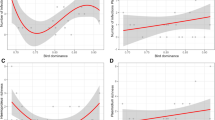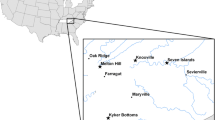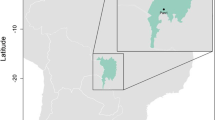Abstract
Establishing how environmental gradients and host ecology drive spatial variation in infection rates and diversity of pathogenic organisms is one of the central goals in disease ecology. Here, we identified the predictors of concomitant infection and lineage richness of blood parasites in New Word bird communities. Our multi-level Bayesian models revealed that higher latitudes and elevations played a determinant role in increasing the probability of a bird being co-infected with Leucocytozoon and other haemosporidian parasites. The heterogeneity in both single and co-infection rates was similarly driven by host attributes and temperature, with higher probabilities of infection in heavier migratory host species and at cooler localities. Latitude, elevation, host body mass, migratory behavior, and climate were also predictors of Leucocytozoon lineage richness across the New World avian communities, with decreasing parasite richness at higher elevations, rainy and warmer localities, and in heavier and resident host species. Increased parasite richness was found farther from the equator, confirming a reverse Latitudinal Diversity Gradient pattern for this parasite group. The increased rates of Leucocytozoon co-infection and lineage richness with increased latitude are in opposition with the pervasive assumption that pathogen infection rates and diversity are higher in tropical host communities.



Similar content being viewed by others
Data Accessibility
The raw dataset is available in the Supporting Information. All unpublished DNA sequences will be available in Genbank and MalAvi.
References
Pianka ER (1966) Latitudinal gradients in species diversity: a review of concepts. Am Nat 100:33–46
Hillebrand H (2004) On the generality of the latitudinal diversity gradient. Am Nat 163:192–211. https://doi.org/10.1086/381004
Rohde K (1992) Latitudinal gradients in species diversity: the search for the primary cause. Oikos 65:514–527. https://doi.org/10.2307/3545569
Willig MR, Kaufman DM, Stevens RD (2003) Latitudinal gradients in biodiversity: pattern, process, scale, and synthesis. Annu Rev Ecol Evol Syst 34:273–309. https://doi.org/10.1146/annurev.ecolsys.34.012103.144032
Guernier V, Hochberg ME, Guégan J-F (2004) Ecology drives the worldwide distribution of human diseases. PLoS Biol 2:e141. https://doi.org/10.1371/journal.pbio.0020141
Jones KE, Patel NG, Levy MA, Storeygard A, Balk D, Gittleman JL, Daszak P (2008) Global trends in emerging infectious diseases. Nature 451:990–993. https://doi.org/10.1038/nature06536
Allen T, Murray KA, Zambrana-Torrelio C, Morse SS, Rondinini C, Di Marco M, Breit N, Olival KJ, Daszak P (2017) Global hotspots and correlates of emerging zoonotic diseases. Nat Commun 8:1124. https://doi.org/10.1038/s41467-017-00923-8
Krasnov BR, Shenbroy GI, Khokhlova IS, Degen AA (2004) Flea species richness and parameters of host body, host geography and host ‘milieu.’ J Anim Ecol 73:1121–1128. https://doi.org/10.1111/j.0021-8790.2004.00883.x
Fecchio et al (2020) An inverse latitudinal gradient in infection probability and phylogenetic diversity for Leucocytozoon blood parasites in New World birds. J Anim Ecol 89:423–435. https://doi.org/10.1111/1365-2656.13117
Matthews KR (2011) Controlling and coordinating development in vector-transmitted parasites. Science 331:1149–1153. https://doi.org/10.1126/science.1198077
Hoarau AOG, Mavingui P, Lebarbenchon C (2020) Coinfections in wildlife: focus on a neglected aspect of infectious disease epidemiology. PLoS Pathog 16(9):e1008790. https://doi.org/10.1371/journal.ppat.1008790
Kotepui KU, Masangkay FR, De Jesus Milanez G, Kotepui M (2021) Prevalence and outcomes of malaria as co-infection among patients with human African trypanosomiasis: a systematic review and meta-analysis. Sci Rep 11:23777. https://doi.org/10.1038/s41598-021-03295-8
Lafferty KD (2009) The ecology of climate change and infectious diseases. Ecology 90:888–900. https://doi.org/10.1890/08-0079.1
Chapa-Vargas L, Matta NE, Merino S (2020) Effects of ecological gradients on tropical avian hemoparasites. In: Santiago-Alarcon D, Marzal A (eds) Avian malaria and related parasites in the tropics, 1st edn. Springer, Cham, pp 349–377
Mordecai EA, Ryan SJ, Caldwell JM, Shah MM, LaBeaud AD (2020) Climate change could shift disease burden from malaria to arboviruses in Africa. Lancet Planet Health 4:e416–e423. https://doi.org/10.1016/S2542-5196(20)30178-9
Oakgrove KS, Harrigan RJ, Loiseau C, Guers S, Seppi B, Sehgal RNM (2014) Distribution, diversity and drivers of blood-borne parasite co-infections in Alaskan bird populations. Int J Parasitol 44:717–727. https://doi.org/10.1016/j.ijpara.2014.04.011
de Angeli DD, Fecchio A, Braga ÉM, Poulin R (2021) Migratory birds have higher prevalence and richness of avian haemosporidian parasites than residents. Int J Parasitol 51:877–882. https://doi.org/10.1016/j.ijpara.2021.03.001
McNew et al (2021) Contrasting drivers of diversity in hosts and parasites across the tropical Andes. Proc Natl Acad Sci U S A 118:e2010714118. https://doi.org/10.1073/pnas.2010714118
Pigeault R, Chevalier M, Cozzarolo CS, Baur M, Arlettaz M, Cibois A, Keiser A, Guisan A, Christe P, Glaizot O (2022) Determinants of haemosporidian single- and co-infection risks in western palearctic birds. Int J Parasitol 52:617–627. https://doi.org/10.1016/j.ijpara.2022.05.002
Kamiya T, O’Dwyer K, Nakagawa S, Poulin P (2014) What determines species richness of parasitic organisms? A meta-analysis across animal, plant and fungal hosts. Biol Rev 89:123–134. https://doi.org/10.1111/brv.12046
Fecchio et al (2021) Global drivers of avian haemosporidian infections vary across zoogeographical regions. Glob Ecol Biogeogr 30:2393–2406. https://doi.org/10.1111/geb.13390
Galen SC, Borner J, Martinsen ES, Schaer J, Austin CC, West CJ, Perkins SL (2018) The polyphyly of Plasmodium: comprehensive phylogenetic analyses of the malaria parasites (order Haemosporida) reveal widespread taxonomic conflict. R Soc Open Sci 5:171780. https://doi.org/10.1098/rsos.171780
Bell AS, De Roode JC, Sim D, Read AF (2006) Within-host competition in genetically diverse malaria infections: parasite virulence and competitive success. Evolution 60:1358–1371. https://doi.org/10.1111/j.0014-3820.2006.tb01215.x
Galen SC, Speer KA, Perkins SL (2019) Evolutionary lability of host associations promotes phylogenetic overdispersion of co-infecting blood parasites. J Anim Ecol 88:1936–1949. https://doi.org/10.1111/1365-2656.13089
Starkloff N, Galen S (2023) Coinfection rates of avian blood parasites increase with latitude in parapatric host species. Parasitology 150:329–336. https://doi.org/10.1017/S0031182022001792
Merino et al (2008) Haematozoa in forest birds from southern Chile: latitudinal gradients in prevalence and parasite lineage richness. Austral Ecol 33:329–340. https://doi.org/10.1111/j.1442-9993.2008.01820.x
Ruhs EC, Martin LB, Downs CJ (2020) The impacts of body mass on immune cell concentrations in birds. Proc R Soc B: Biol Sci 287:20200655. https://doi.org/10.1098/rspb.2020.0655
Minias P (2019) Evolution of heterophil/lymphocyte ratios in response to ecological and life-history traits: a comparative analysis across the avian tree of life. J Anim Ecol 88:554–565. https://doi.org/10.1111/1365-2656.12941
Barrow LN, McNew SM, Mitchell N, Galen SC, Lutz HL, Skeen H, Valqui T, Weckstein JD, Witt CC (2019) Deeply conserved susceptibility in a multi-host, multi-parasite system. Ecol Lett 22:987–998. https://doi.org/10.1111/ele.13263
Fecchio et al (2019) Avian host composition, local speciation and dispersal drive the regional assembly of avian malaria parasites in South American birds. Mol Ecol 28:2681–2693. https://doi.org/10.1111/mec.15094
Fecchio et al (2022) Beta diversity, prevalence, and specificity of avian haemosporidian parasites throughout the annual cycle of Chilean Elaenia (Elaenia chilensis), a Neotropical austral migrant. Parasitology 149:1760–1768. https://doi.org/10.1017/S0031182022001317
Hellgren O, Waldenström J, Bensch S (2004) A new PCR assay for simultaneous studies of Leucocytozoon, Plasmodium, and Haemoproteus from avian blood. J Parasitol 90:797–802. https://doi.org/10.1645/GE-184R1
Bell JA, Weckstein JD, Fecchio A, Tkach VV (2015) A new real-time PCR protocol for detection of avian haemosporidians. Parasit Vectors 8:383. https://doi.org/10.1186/s13071-015-0993-0
Stephens M, Smith NJ, Donnelly P (2001) A new statistical method for haplotype reconstruction from population data. Am J Hum Genet 68:978–989
Stephens M, Donnelly P (2003) A comparison of Bayesian methods for haplotype reconstruction from population genotype data. Am J Hum Genet 73:1162–1169
Harrigan RJ, Sedano R, Chasar JA, Nguyen JT, Whitaker A, Smith TB (2014) New host and lineage diversity of avian haemosporidians in the northern Andes. Evol Appl 7:799–811. https://doi.org/10.1111/eva.12176
Bensch S, Pérez-Tris J, Waldenström J, Hellgren O (2004) Linkage between nuclear and mitochondrial DNA sequences in avian malaria parasites: multiple cases of cryptic speciation? Evolution 58:1617–1621. https://doi.org/10.1554/04-026
Bensch S, Hellgren O, Pérez-Tris J (2009) MalAvi: a public database of malaria parasites and related haemosporidians in avian hosts based on mitochondrial cytochrome b lineages. Mol Ecol Resour 9:1353–1358. https://doi.org/10.1111/j.1755-0998.2009.02692.x
Fick SE, Hijmans RJ (2017) WorldClim 2: new 1-km spatial resolution climate surfaces for global land areas. Int J Climatol 37:4302–4315. https://doi.org/10.1002/joc.5086
De La Torre GM, Campião KM (2021) Bird habitat preferences drive hemoparasite infection in the Neotropical region. Integr Zool 16:755–768. https://doi.org/10.1111/1749-4877.12515
Tobias et al (2022) AVONET: morphological, ecological and geographical data for all birds. Ecol Lett 25:581–597. https://doi.org/10.1111/ele.13898
R Core Team (2017) A language and environment for statistical computing. R Foundation for Statistical Computing
Jetz W, Thomas GH, Joy JB, Hartmann K, Mooers AO (2012) The global diversity of birds in space and time. Nature 491:444–448. https://doi.org/10.1038/nature11631
Bürkner PC (2017) brms: an R package for Bayesian multilevel models using Stan. J Stat Softw 80: 27239. https://doi.org/10.18637/jss.v080.i01
Svensson E, RÅberg L, Koch C, Hasselquist D (1998) Energetic stress, immunosuppression and the costs of an antibody response. Funct Ecol 12:912–919. https://doi.org/10.1046/j.1365-2435.1998.00271.x
González AD, Matta NE, Ellis VA, Miller ET, Ricklefs RE, Gutiérrez HR (2014) Mixed species flock, nest height, and elevation partially explain avian haemoparasite prevalence in Colombia. PLoS ONE 9:e100695. https://doi.org/10.1371/journal.pone.0100695
Lotta IA, Pacheco MA, Escalante AA, González AD, Mantilla JS, Moncada LI, Adler PH, Matta NE (2016) Leucocytozoon diversity and possible vectors in the Neotropical highlands of Colombia. Protist 167:185–204. https://doi.org/10.1016/j.protis.2016.02.002
McCreadie JW, Adler PH, Hamada N (2005) Patterns of species richness for blackflies (Diptera: Simuliidae) in the Nearctic and Neotropical regions. Ecol Entomol 30:201–209. https://doi.org/10.1111/j.0307-6946.2005.00681.x
Ramiro RS, Pollitt LC, Mideo N, Reece SE (2016) Facilitation through altered resource availability in a mixed-species rodent malaria infection. Ecol Lett 19:1041–1050. https://doi.org/10.1111/ele.12639
Mcqueen PG, Mckenzie FE (2006) Competition for red blood cells can enhance Plasmodium vivax parasitemia in mixed-species malaria infections. Am J Trop Med Hyg 75:112–125
Chakarov N, Veiga J, Ruiz-Arrondo I, Valera F (2021) Atypical behavior of a black fly species connects cavity-nesting birds with generalist blood parasites in an arid area of Spain. Parasit Vectors 14:298. https://doi.org/10.1186/s13071-021-04798-z
Acknowledgements
We thank numerous ornithologists and field assistants for their help with sampling birds. We also thank all collaborators who contributed to previously published data as well as the authors that made their data publicly available. We are in debt to the governmental agencies from Brazil and the USA for issuing all permits necessary for collection of new blood samples. Field collection and reagents for molecular analyses were funded in part by National Science Foundation grants DEB-1503804 to JDW.
Author information
Authors and Affiliations
Contributions
AF and DAD conceived the idea, designed the research, and wrote the manuscript. DAD ran the analyses. EJW, JDW, and JHD generated new data. JAB curated the data. All authors contributed critically to the manuscript drafts and gave final approval for publication.
Corresponding author
Ethics declarations
Competing interests
The authors declare no competing interests.
Conflict of Interest
The authors declare no competing interests.
Supplementary Information
Below is the link to the electronic supplementary material.
Rights and permissions
Springer Nature or its licensor (e.g. a society or other partner) holds exclusive rights to this article under a publishing agreement with the author(s) or other rightsholder(s); author self-archiving of the accepted manuscript version of this article is solely governed by the terms of such publishing agreement and applicable law.
About this article
Cite this article
Fecchio, A., Bell, J.A., Williams, E.J. et al. Co-infection with Leucocytozoon and Other Haemosporidian Parasites Increases with Latitude and Altitude in New World Bird Communities. Microb Ecol 86, 2838–2846 (2023). https://doi.org/10.1007/s00248-023-02283-x
Received:
Accepted:
Published:
Issue Date:
DOI: https://doi.org/10.1007/s00248-023-02283-x




